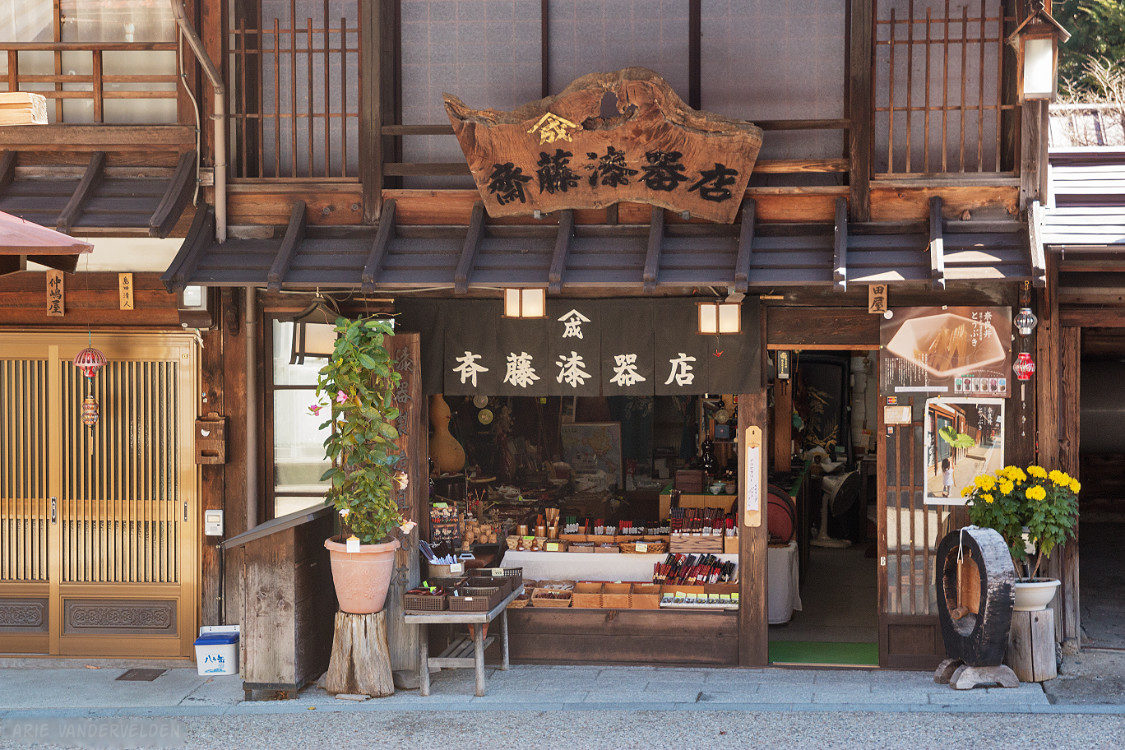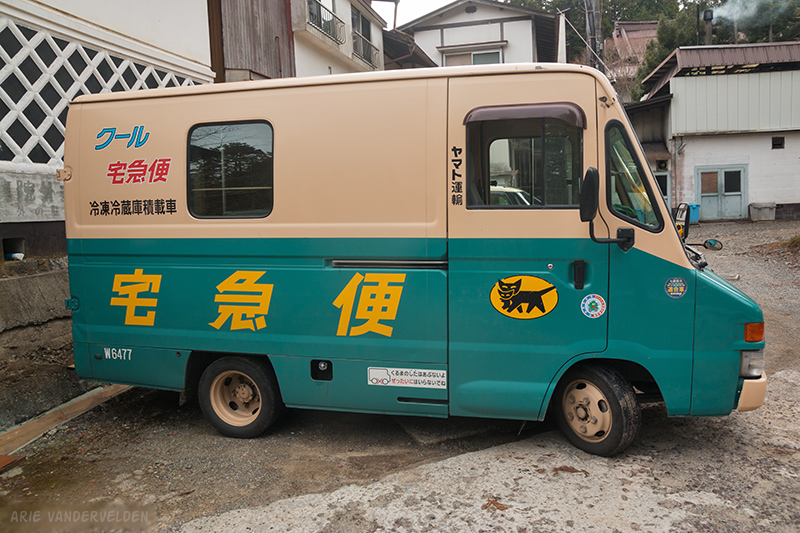The Nakasendo Way ( 中 山 道 in Japanese) is an old route through the mountains of central Honshu. It connected Edo (Tokyo) with Japan’s old capital city of Kyoto. Although its beginnings have been traced back to the eighth century, the heyday of the Nakasendo Way was during the Edo period (17th, 18th, and early 19th centuries) when pilgrims, samurai warriors, and nobility traveled up and down the path. Post-towns sprang up at regular intervals along the route to accommodate the travelers.
Nowadays, large sections of the old Nakasendo way have been paved over or have disappeared beneath modern towns and cities. But portions of the old trail still exist, and some of the old post towns have been carefully restored to their former glory. These old sections of trail have been stitched together by plotting a course along modern roads and paths to connect the post-towns. The modern Nakasendo Way, then, follows hiking trails through the forest, country roads through farm fields, sidewalks through towns, and on occasion the shoulders of major highways where other options do not exist. The result is an enjoyable mix of historical sights and rural everyday Japan.
Most modern hikers do not walk the full 500 km from Tokyo to Kyoto. Rather, people pick and choose sections that interest them. The short hike between the post-towns of Tsumago and Magome is the most famous section; it is well-described in guidebooks such as Lonely Planet and Rough Guides and it is well-visited by foreign tourists. Other sections take more sleuthing to plan and find your way. We hiked a section of the Nakasendo in November of 2018, and returned in November of 2023 to hike some other sections. This blog post presents a composite of those two trips.
Matsumoto
From Tokyo we took the train to Matsumoto, a small city at the head of the Kiso Valley. Matsumoto isn’t really on the Nakasendo Way, but it has a well-preserved wooden castle that is worth a look.

Matsumoto is more than just a quick stop to look at the castle. We really liked the compact inner city. It has a laid-back vibe, some nice shops, good-value business hotels, and great dining scene. Here is a picture of a historic building in Matsumoto, wedged between two modern concrete buildings. Its architecture mimics that of the castle. To me it symbolizes the preservation of the Nakasendo Way; the old and the new.

We returned to Matsumoto Castle at sunset. It had been a cool crisp day, and as soon as the sun set the temperature plummeted. We shivered as we hiked back to our hotel, vowing to bring our jackets and sweaters along next time we’d go out in the evening.

Hotaka Wasabi Farm
Just to the north of Matsumoto is a village called Hotaka, famous for its wasabi production. We took a daytrip out here to have a look around before starting the Nakasendo trail. At Hotaka, cold streams that flow from the mountains converge. Water flows through porous gravel beds, creating an ideal environment for growing wasabi – Japanese horseradish. Wasabi is served as a condiment with sushi.
We took a local train (Oito line) a few stops to the north of Matsumoto. After alighting we started walking to the west – first through the town, and then through open fields. Dark ominous clouds hid the mountains, but it was sunny in the valley where we were hiking.
We stopped at a little roadside shrine.

This stone jizo statue speaks of love.

After about 3 km of walking we arrived at the wasabi farm.
Wasabi is an aqueous plant that grows in saturated gravel. It doesn’t like the summer sun, so plastic sheeting is used to shade the plants. It was late fall, so the black plastic sheeting was rolled up and we could see the plants.

Here is Diana next to a statue of a wasabi root. The roots are ground up into a paste, which is eaten.

At the wasabi farm there was a restaurant and gift shop. We ordered some wasabi croquettes. We bit into them expecting fireworks, but … nothing. Next, we tried wasabi ice cream. Again, we expected a strong kick but there was nothing. Disappointed, we bought some wasabi potato chips which we brought back to our hotel in Matsumoto. Expecting to be disappointed once again, we started snacking on them. Before long our eyes were watering and our sinuses were on fire. Finally – wasabi.
Hideshio to Narai
We started our Nakasendo hike in the village of Hideshio, south of Matsumoto.

From the train station we walked south along the main street., where there were some pretty traditional houses.

At the edge of town, the street merges with highway 19, the main trucking route through the Kiso valley. An underpass allowed us to get to the other side of the highway (right side heading south) where there was room to walk behind the guardrail.
After a short distance, the highway headed into a tunnel. Rather than entering the tunnel, we crossed the highway on a crosswalk and followed a local road to the south. This road went through lush forest and wash perched above a tumbling stream. The hiking was very pleasant here. This road ended at a small village where the old Nakasedo road is still preserved. There is good signage in this area.

At the edge of this small village, the country road met up with the highway. We crossed the highway on a crosswalk, followed it behind the guardrail for 100 m or so, and then headed uphill. We followed local roads to the village of Niekawa, where there is a train station. In several places there are roads that head left, down to the highway, but we stayed right, on local roads above the highway. Signage is poor along this section.
We crossed the train tracks at the “singing bridge.” The singing bridge is about 400 m south of the Niekawa train station.

Past the singing bridge, the road through Niekawa follows the old Nakasendo Way. Past the townsite, we kept on following the local road for about 1.5 km until it met up with the highway. We hiked along the highway for a short distance, and then followed a local road behind some buildings. This hamlet is called Nagase.
Past Nagase, we followed the highway for a short distance, crossed on a crosswalk, and walked along a service road to the entrance of Hirasawa. Hirasawa is a pretty town along the Nakasendo road. Harsh afternoon light stymied my efforts to photograph it. Hirasawa is a town known for its laquerware, and there are many shops in town selling just that.
Past Hirasawa we followed a local road along the river which led to our destination for the night: Narai.
Narai
Narai is one of the best-preserved and best-restored post towns along the Nakasendo Way. Historic houses line the main street for a full kilometer.


Laquerware store.

Diana had a cold, and bought a herbal remedy from a pharmacy.

Sign outside of the pharmacy.

Narai is photogenic. I enjoyed photographing decorations that hang from people’s doors.



Radishes for sale.

Shredded daikon radishes drying.

Water spouts are a sign of hospitality.


At the north end of town is a shrine with many jizo statues.


In Narai we stayed at Minshuku Shimada, a traditional Japanese hotel. There was an onsen (spa bath), and dinner and breakfast were included. Here we are cooking shabu-shabu (hotpot).

Narai to Yabuhara (Torii Pass)
This popular three-hour hike starts at the temple on the southern outskirts of town.

The trail heads into the forest and starts heading up to Torii Pass. Feeling a bit under the weather, we hiked partway up and turned around.

Statue along the way.

Continue to part two of our Nakasendo hike.
Logistics
There is a direct train from Tokyo (Shinjuku station) to Matsumoto. The journey takes about three hours. There is a friendly tourist information center in the Matsumoto train station. There is also a tourist info in Kiso-Fukushima, opposite the train station.
The Kiso Valley is served by a local train that goes from Matsumoto to Nakatsugawa. Some trains stop at every village, about every 5 km or so. Other trains stop only at bigger towns such as Kiso-Fukushima. It’s a good idea to get a schedule from the tourist office in Matsumoto. Stops are announced in English.
Some stations are staffed and others are not. At the staffed stations you can buy a ticket, or else you can pay the train driver. You enter the train at the rear. If you don’t have a prepaid ticket, take one from the machine. Short hops cost only a few hundred yen (a few dollars). Exit at the front, and pay the driver or else give him your prepaid ticket. The tourist info can give you a train schedule.

You don’t have to carry your big suitcase with you when hiking the Nakasendo Trail. You can send your luggage ahead using the Takkyubin service, and carry with you only a small bag with enough supplies for a few days of hiking. Takkyubin is like a courier service; you can ship just about anything to just about anywhere in Japan. Unlike British luggage shuttles for hikers, Takkyubin is not a same-day service. Delivery is next day (earliest) or else you can specify a delivery date up to a week ahead.
To drop off a bag, look for a shop with the green-and-yellow cat symbol. You’ll have to fill out a form, but the form has boxes with both Japanese and English descriptions. We put the destination’s address in English and the bag arrived just fine. Shipping a large backpack cost us about 20 Canadian dollars (less than 2,000 yen).

There are some public washrooms along the trail. All train stations have public washrooms. The public washrooms are modern and clean. For those wanting to save money by camping: please note that random camping is frowned upon in Japan.
To navigate, I used a booklet called “Shinsyu Kisoji – Nakasendo Walking Map” published by the Kiso Tourist Federation. Unfortunately, this tremendously helpful schematic map is not available online as a pdf. I picked up a copy locally on my 2017 hike, and put it to good use on my 2023 hike. The other source of information is Google Maps. In many places the old Nakasendo is marked.
Hideshio to Narai is a 13.5 km walk.
- In Matsumoto we stayed at the Alpico Plaza Hotel (2018) and Hotel Morschein (2023). Both are recommended.
- In Narai we stayed at Minshuku Shimada. This is a traditional inn along the main street of Narai. The owners are friendly and accommodating, and dinner is a gourmet affair. Finding the inn is a little tricky because there is no English signage. Highly recommended.
